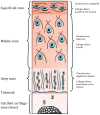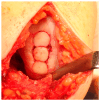Cartilage Integrity: A Review of Mechanical and Frictional Properties and Repair Approaches in Osteoarthritis
- PMID: 39201206
- PMCID: PMC11353818
- DOI: 10.3390/healthcare12161648
Cartilage Integrity: A Review of Mechanical and Frictional Properties and Repair Approaches in Osteoarthritis
Abstract
Osteoarthritis (OA) is one of the most common causes of disability around the globe, especially in aging populations. The main symptoms of OA are pain and loss of motion and function of the affected joint. Hyaline cartilage has limited ability for regeneration due to its avascularity, lack of nerve endings, and very slow metabolism. Total joint replacement (TJR) has to date been used as the treatment of end-stage disease. Various joint-sparing alternatives, including conservative and surgical treatment, have been proposed in the literature; however, no treatment to date has been fully successful in restoring hyaline cartilage. The mechanical and frictional properties of the cartilage are of paramount importance in terms of cartilage resistance to continuous loading. OA causes numerous changes in the macro- and microstructure of cartilage, affecting its mechanical properties. Increased friction and reduced load-bearing capability of the cartilage accelerate further degradation of tissue by exerting increased loads on the healthy surrounding tissues. Cartilage repair techniques aim to restore function and reduce pain in the affected joint. Numerous studies have investigated the biological aspects of OA progression and cartilage repair techniques. However, the mechanical properties of cartilage repair techniques are of vital importance and must be addressed too. This review, therefore, addresses the mechanical and frictional properties of articular cartilage and its changes during OA, and it summarizes the mechanical outcomes of cartilage repair techniques.
Keywords: cartilage; cartilage biomechanics; cartilage friction; friction; osteoarthritis; wear.
Conflict of interest statement
The authors declare no conflict of interest.
Figures












References
-
- Krakowski P., Karpiński R., Maciejewski R., Jonak J. Evaluation of the Diagnostic Accuracy of MRI in Detection of Knee Cartilage Lesions Using Receiver Operating Characteristic Curves. J. Phys. Conf. Ser. 2021;1736:012028. doi: 10.1088/1742-6596/1736/1/012028. - DOI
-
- Karpiński R., Krakowski P., Jonak J., Machrowska A., Maciejewski M. Comparison of Selected Classification Methods Based on Machine Learning as a Diagnostic Tool for Knee Joint Cartilage Damage Based on Generated Vibroacoustic Processes. Appl. Comput. Sci. 2023;19:136–150. doi: 10.35784/acs-2023-40. - DOI
-
- Machrowska A., Karpiński R., Maciejewski M., Jonak J., Krakowski P. Application of Eemd-Dfa Algorithms and Ann Classification for Detection of Knee Osteoarthritis Using Vibroarthrography. Appl. Comput. Sci. 2024;20:90–108. doi: 10.35784/acs-2024-18. - DOI
Publication types
LinkOut - more resources
Full Text Sources

